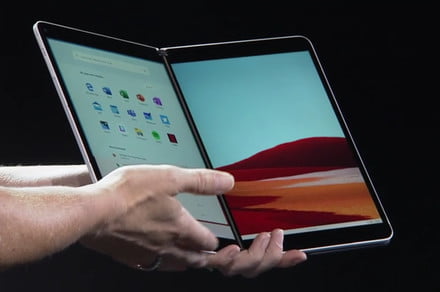After endless hints, rumors, and reports, Microsoft finally unveiled its vision for the future of dual-screen devices. It’s called Windows 10 X, and it’s the software that runs Microsoft’s new platform for devices with two screens.
Windows 10 X is designed to take advantage of a device like the Surface Neo and the newly teased Surface phones, while also balancing its functionality as a proper Windows 10 device. These dual-screen devices don’t have physical keyboards attached, so Windows 10 X has to make up for that with a more helpful virtual keyboard.
If you want a keyboard, though, don’t fret too much. You can still attach a physical keyboard, and Microsoft showed such an accessory available for the Surface Neo. It’s a clever incarnation of an external keyboard that can be positioned at different points on the device. Its position changes how the device works, either enabling a portion of the screen for using apps, enabling a touchscreen, or other features.
Keep the keyboard on the bottom half of a screen, for example, and the Wonder Bar is enabled. This is a software-driven use of the remaining screen space that works as a fully functional touchscreen. Microsoft has labeled these new usage modes as Postures.
You can also use third-party Bluetooth computers or dock a device to use a regular wired keyboard and device. This is still Windows, after all.
While Windows 10 X feels different, it keeps a lot of the most familiar elements of Windows 10, whether it’s the Start menu or the Taskbar. You can still pin apps or websites and launch them from here just as you would in Windows 10.
All your Windows 10 or Win32 applications will still work in Windows 10 X, too. Unlike the now-retired Windows 10 S (or Windows 10 in S Mode), Windows 10 X isn’t restricted to applications downloaded in the Microsoft Store. These are still Windows 10 devices through and through.
Microsoft says developers won’t have to do anything special to make apps function properly in Windows 10 X. Regardless of what it is, the app should automatically adapt to either one-pane or two-pane modes.
Despite the new functionality, Microsoft is insistent that Windows 10 X isn’t a new operating system. Instead, it’s part of Core OS, a modular expression of Windows 10 that extends Windows 10 beyond devices with a traditional form factor. It’s the same philosophy that brought Windows 10 to devices like the Xbox, HoloLens, and Surface Hub.
Windows 10 X will be rolling out in dual-screen devices in time for the holiday 2020 season. So far, manufacturers like Dell, HP, Lenovo, and Asus are all partnering with Microsoft on some kind of dual-screen device in the future.

